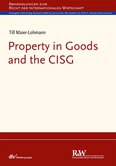251 § 8: Insolvency and property in the goods
559
The relationship between the CISG and insolvency laws has not been discussed in-depth in literature.1140 For the most part, it is a question of the relationship between national laws and the CISG. Although there have been notable developments and unification efforts to facilitate the handling of international insolvencies, for example, the UNCITRAL Model Law on Cross-Border Insolvency (1997) and on the European level the Regulation (EU) 2015/848 on Insolvency Proceedings (Recast) of 2015, these efforts are mainly targeted at determining the competent court, procedural aspects, and the applicable law.1141 In terms of substantive insolvency law, the four-part UNCITRAL Legislative Guide on Insolvency Law1142 contains many guiding principles, for example regarding priorities and distribution of proceeds.1143 However, UNCITRAL’s Legislative Guides are less likely to achieve unification of laws compared to Conventions or Model Laws.1144 On the other hand, the Legislative Guides provide more flexibility.1145 On the European level, the substantive insolvency law has come more and more into focus and resulted, inter alia, in the new Directive (EU) 2019/1023 on Restructuring and Insolvency,1146 which only addresses a part of corporate insolvency law.1147 Notwithstanding these numerous projects, parties to a CISG contract face widely differing national substantive insolvency laws.
560
The interplay poses difficult questions such as the status of the contract before and during insolvency proceedings;1148 whether the calculation of loss within remedies under national insolvency laws is influenced by the CISG; whether additional remedies are available to an insolvency administrator besides the contractual remedies under the CISG;1149 and more.1150 These questions fall outside the scope of this work. Yet, in assessing the relevance of property in international sales transactions, the insolvency of one of the contractual parties will bring questions of property to the forefront of all interested parties’ minds.1151 Consequently, the interplay between the CISG and insolvency laws has to be analyzed as far as property in the goods is concerned.
| 1140 | But see Schmidt-Kessel, FS Schlechtriem, pp. 255 et seq. |
| 1141 | This statement may be only partially true for the European Regulation on Insolvency Proceedings which is considered to contain some substantive rules under the surface, for example, with regard to inter alia retention of property clauses, cf. Wessels, 8 European Company Law (2011), 27, 29 regarding the (in this regard unchanged) version of 2002 of the regulation. Cf. also Opinion of the Advocate-General Colomer, Case C-339/07, Christopher Seagon v Deko Marty Belgium NV, 16 October 2008, para. 59: “There have been other developments in the secondary legislation on the subject, all of which have the same aim and together form the body of Community insolvency law” and the accompanying footnote that references multiple regulations. |
| 1142 | UNCITRAL Legislative Guide on Insolvency Law, Parts One and Two (2004); UNCITRAL Legislative Guide on Insolvency Law, Part Three: Treatment of Enterprise Groups in Insolvency (2010); UNCITRAL Legislative Guide on Insolvency Law, Part Four: Directors’ Obligations in the Period Approaching Insolvency (2013/2019). All parts are available on the UNCITRAL website. |
| 1143 | UNCITRAL Legislative Guide on Insolvency Law, Part Two (2004), pp. 266–275. |
| 1144 | Lehavi, p. 261. |
| 1145 | Lehavi, p. 261; Block-Lieb/Halliday, 42 Texas International Law Journal (2007), 475, 479 who refer to Legislative Guides as “new legal technologies” of UNCITRAL. |
| 1146 | Directive (EU) 2019/1023 of the European Parliament and of the 20 June 2019 on preventive restructuring frameworks, on discharge of debt and disqualifications, and on measures to increase the efficiency of procedures concerning restructuring, insolvency and discharge of debt, and amending Directive (EU) 2017/1132. |
| 1147 | de Weijs, 15 European Company and Financial Law Review (2018), 403, 404. |
| 1148 | Staudinger/Magnus, Vorbemerkungen zu Art 81ff. para. 6. |
| 1149 | See for example, Helen Kaminski Pty. Ltd v. Marketing Australian Products, Inc., US District Court for the Southern District of New York, 21 July 1997, CISG-online 297 where a party argued that the insolvent contractual partner could not rely on sect. 108(b) Bankruptcy Code of the USA to gain an additional period of time to cure, since the national Bankruptcy Code was superseded by the CISG as an international convention. The court found the CISG not to be applicable which is why it did not have to assess the question of supersession. |
| 1150 | Cf. Schmidt-Kessel, FS Schlechtriem, pp. 255 et seq. |
| 1151 | Cf. Burrows, Remedies, p. 495 who states that the allocation in insolvency is the “most significant consequence of deciding whether property in goods has passed or not”; Bridge/Gullifer/Low/McMeel, para. 18-019; Schwenzer/Muñoz, para. 39.04. |


